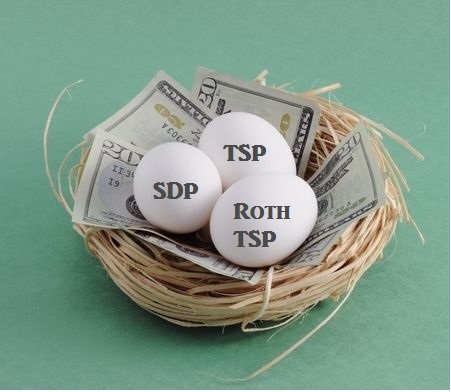
part 4 of an 8-part series
Up until now the first three parts of this series on the Pillars of Personal Financial Success have focused mostly on strategies; topics of establishing and maintaining good credit, achieving financial stability, and committing to routine savings. Now it’s time to focus on tools that will help get you to where you want to go. There are two tools, Thrift Savings Plan (TSP) and the Savings Deposit Program (SDP), which are specific to the military community; Active-duty, Guard and Reserve and those deploying to a combat zone. There are specific guidelines and rules about saving through these plans so make sure you check with your finance office and/or get more information at DFAS.mil and TSP.gov. This blog will provide some key information to get you thinking about how you can leverage these two products to become more financially ready!
Thrift Savings Plan (TSP)
TSP is basically a 401(K) plan for the military. One of the main differences from other company 401(K) plans is there is no company match (plus an array of other differences which make TSP very attractive as well.) The reasoning behind the “no match” is that the military offers a significant retirement plan for eligible retirees, usually beginning at the 20-year of service mark. That being said, the retirement entitlement may not always remain the same and even if the retirement entitlement stays the same, there is never a guarantee that you will remain in the military for at least 20 years. So it is vitally important you take advantage of some sort of retirement savings plan – and the TSP is a GREAT place to start. One of the major benefits of TSP is that the administrative fees are very low, over the last five years the fees have been about 0.027% (or 27 cents per every $1,000 invested). Here are six other important things to know about TSP.
1.TSP has two different accounts as far as tax liability goes. Without getting too far into the weeds, simply put, TSP has a regular TSP and Roth TSP. The main difference is with the regular TSP you money goes in pre-tax, which helps to lower your adjusted gross income at year-end tax time, but the money will be taxed when you withdraw it. With the Roth TSP your money goes in after taxes, so your money will be tax-free when you withdraw it later. When you receive tax-free pay and opt to directly fund your TSP or Roth TSP there are specific rules associated with this, however, one of the best benefits is that this money will not be taxed (there are certain restrictions with funding with TSP or TSP Roth with tax-free earnings, check out this TSP document for more detailed tax informaiton). If you meet the requirements, tax-free pay directed into your Roth TSP is a fantastic option.
2.TSP has no matching funds for military servicemembers. As stated above, this is true today. However, circumstances could change and make TSP even more attractive in the future.
3.TSP has five main funds. The G Fund, F Fund, C Fund, S Fund, and I Fund plus the Lifecycle (L) Funds which are a mixture of the G, F, C, S and I funds that re-allocate over time as you get closer to your retirement year. Having a good mix of these funds will diversify your account.
4.Diversification is an important part of investing and saving for the long-term. There are more risks but, especially for young people, the benefits of diversifying your portfolio (i.e., funds in your TSP) can far outweigh the risks. But make sure you are comfortable with what you are doing. You can check TSP.gov for how each one of the Funds has done overtime to see where you want your funds to be.
5.The TSP “default” option is the G Fund (government securities). This is a no-loss fund. There is only potential for growth, however, the growth is nominal and will not diversify your money in the account.
6.Lifecycle (L) Funds are like putting your retirement on auto-pilot. The L Funds are timed according to your future date of retirement and will reallocate their distribution into the 5 main TSP funds to adjust from taking more risk at a younger age (further from retirement) to being more conservative as your retirement year gets closer.
Savings Deposit Program (SDP)
SPD was created as a special savings account for those deploying to a combat zone. The interest-bearing account gives a high rate of return at up to 10% annually on up to a total of $10,000 in funds. There are specific circumstances with this account and it can only be set-up after you have been deployed for 30 consecutive days. The Defense Finance and Accounting Service (DFAS) offers a full explanation on their website. Basically, it is a short-term, high-return savings account. Everyone deploying should be taking advantage of this awesome opportunity. Even if you cannot save the whole $10,000 – you can still receive up to 10% interest annually on whatever you can put in.
Part 1: Pillars of Personal Financial Success – Tips for Everyone to Maintain or Build Good Credit
Part 2: Pillars of Personal Financial Success – Tips to Achieve Financial Stability
Part 3: Pillars of Personal Financial Success – 3 Tips to Help you Commit to Routine Savings
Stay tuned the next blog in our series: Enrolling the Servicemembers Group Life Insurance (SGLI)
Related article in the Stars and Stripes: Military savers favoring ‘Roth’ Thrift Savings Plan to build nest eggs
By: Andia Dinesen, AFC®
VP Communications and Operations
Association of Military Banks of America (AMBA)